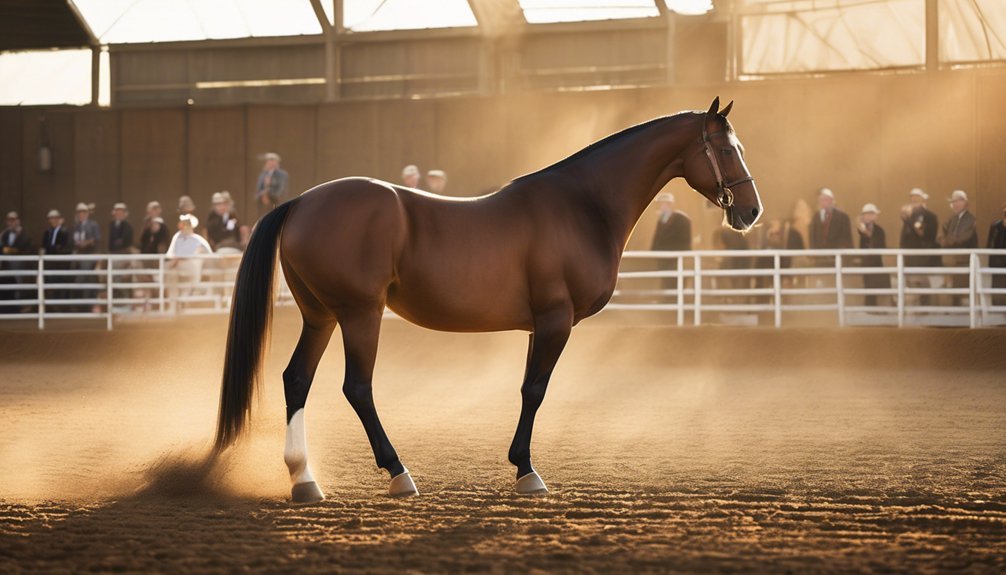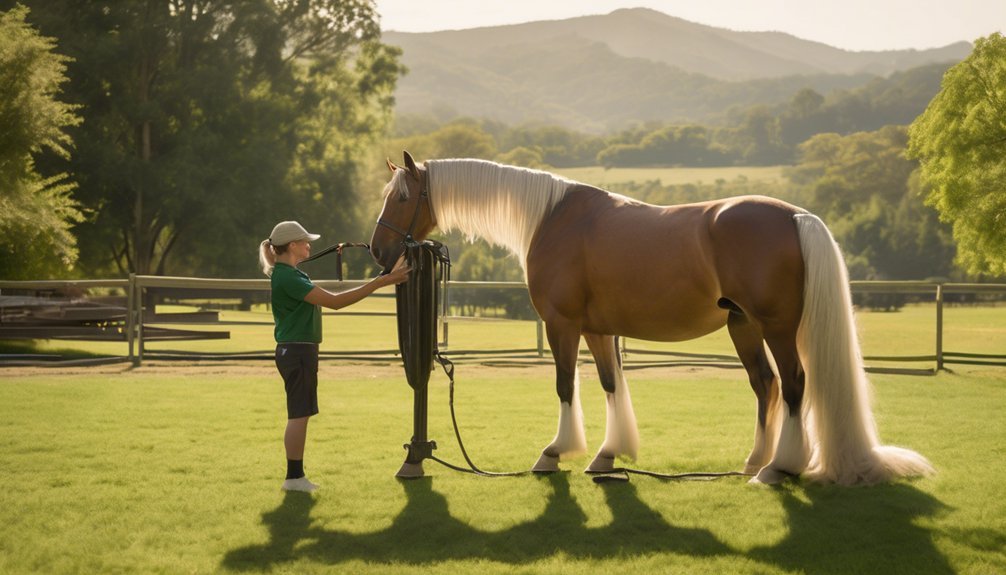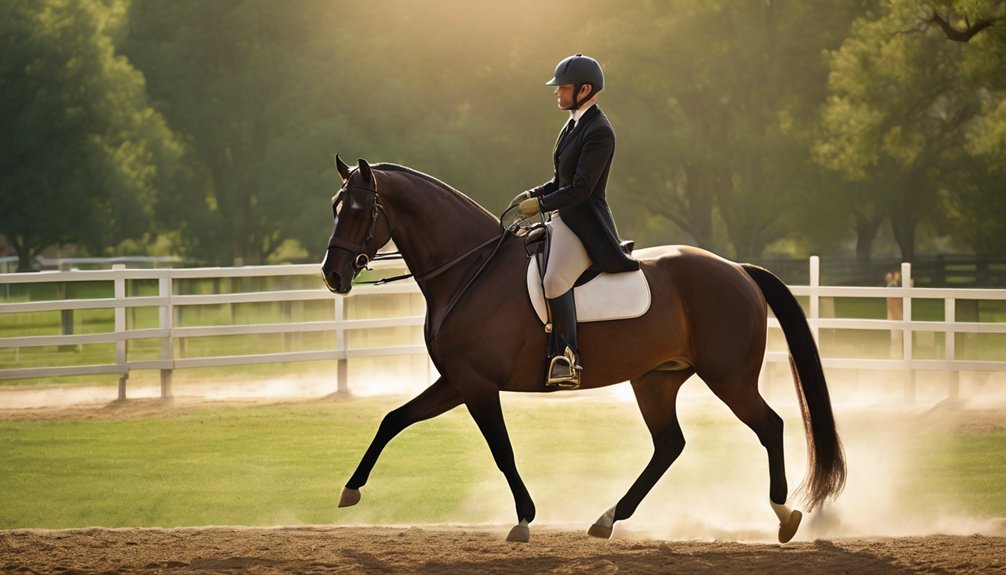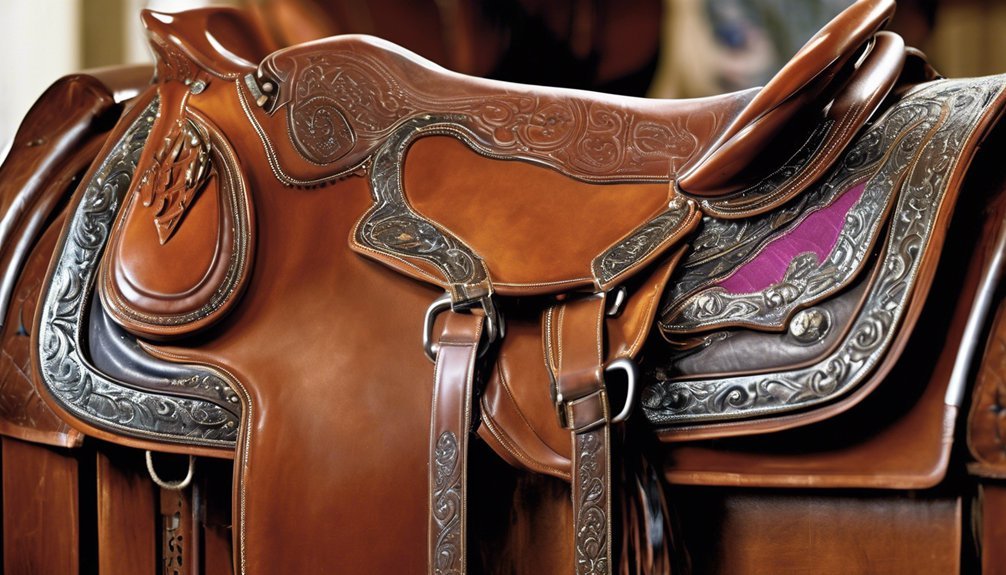
Imagine preparing a halter horse for a prestigious competition, where every detail matters. To achieve optimal performance, it's crucial to implement a structured conditioning program that develops muscle tone, stamina, and flexibility. This involves more than just exercise; it requires a comprehensive approach that includes nutrition and presentation techniques. Understanding how to balance these elements can make all the difference in your horse's success. What specific strategies can you adopt to enhance your horse's conditioning?
Key Takeaways
- Develop an exercise routine that includes interval training, strength exercises, and consistent warm-ups and cool-downs tailored to your horse's fitness level.
- Focus on targeted muscle-building exercises such as lunging, backing up, and hill work to enhance muscle tone and balance.
- Incorporate aerobic activities like long rides to improve stamina and gradually increase intensity for optimal endurance without risking injury.
- Ensure your horse's diet includes essential nutrients, with enough protein, carbohydrates, fats, vitamins, and minerals to support performance and recovery.
- Foster a strong bond with your horse through regular handling and training sessions, enhancing both confidence and performance in the show ring.
Understanding the Importance of Conditioning for Halter Horses

When you consider entering a halter horse in competition, understanding the importance of conditioning can't be overstated. Proper conditioning not only enhances your horse's physical appearance but also ensures competition readiness.
A well-conditioned halter horse exhibits muscle tone, balance, and an overall polished look that judges seek. Regular exercise promotes stamina and flexibility, allowing your horse to perform confidently in the ring.
Additionally, conditioning fosters a strong bond between you and your horse, creating a sense of partnership essential for success. By prioritizing conditioning, you're investing in your horse's health and performance, setting the stage for impressive showings.
Ultimately, consistent effort in conditioning elevates your halter horse's potential, helping you achieve your competition goals together.
Designing an Effective Exercise Routine
Designing an effective exercise routine is vital for maximizing your halter horse's performance and appearance. Start by incorporating interval training, which enhances your horse's stamina and flexibility. Alternate between high-intensity bursts of movement and periods of recovery, allowing your horse to build endurance while preventing fatigue.
Next, add strength exercises to develop muscle tone and overall body condition. Utilize ground work, such as lunging and backing up, to engage various muscle groups.
Don't forget to prioritize consistent warm-ups and cool-downs to promote flexibility and prevent injury. Tailor your routine to your horse's unique needs and fitness level, ensuring it remains enjoyable and rewarding.
Regular assessments will help you adapt your program as your horse progresses, fostering a strong bond through shared growth.
Building Muscle and Tone
To effectively build muscle and tone in your halter horse, focus on targeted exercises that engage specific muscle groups while promoting overall body condition.
Incorporate groundwork and lunging to enhance muscle development, emphasizing movements that encourage the horse to stretch and flex.
Utilize hill work or resistance training, such as pulling weighted sleds, to stimulate tone enhancement.
These exercises not only strengthen your horse but also improve balance and posture, essential for competition success.
Consistency is key, so maintain a regular schedule and adjust intensity based on your horse's progress.
Enhancing Stamina and Endurance

While conditioning your halter horse for competition, enhancing stamina and endurance is crucial for maintaining peak performance throughout the event.
To achieve this, incorporate interval training into your regimen. This involves alternating between high-intensity bursts of activity and periods of rest, which effectively improves your horse's cardiovascular capacity.
Pair this with aerobic exercises, such as long, steady rides, to build a strong endurance foundation. Gradually increase intensity and duration to avoid injury, and always monitor your horse's response to the training.
Remember, consistency is key; regular workouts will lead to noticeable improvements.
Nutrition: Fueling Your Halter Horse
Nutrition plays a vital role in preparing your halter horse for competition, as the right diet not only fuels their performance but also supports overall health. A well-planned feeding schedule ensures your horse gets the necessary nutrients, while nutritional supplements can further enhance their vitality.
Here's a simple breakdown of essential nutrients:
| Nutrient | Function |
|---|---|
| Protein | Builds muscle and repair tissue |
| Carbohydrates | Provides energy for workouts |
| Fats | Supports skin and coat health |
| Vitamins | Boosts immunity and performance |
| Minerals | Aids in bone and muscle strength |
Grooming and Presentation Techniques
Grooming and presentation techniques are crucial for showcasing your halter horse to its best advantage in the competition ring. Proper grooming not only enhances your horse's appearance but also reflects your commitment as an owner.
Here are some essential grooming techniques and presentation tips:
- Brush thoroughly: Use a curry comb and soft brush to remove dirt and debris.
- Hoof care: Clean and polish hooves to highlight their shape and health.
- Tail and mane: Braid or band the mane and tail neatly to prevent tangling.
- Conditioning products: Apply shine spray for a glossy finish.
- Practice standing: Train your horse to stand squarely, showcasing its conformation.
Monitoring Progress and Adjusting the Plan

To ensure your halter horse is prepared for competition, it's essential to continuously monitor its progress and adjust your training plan as needed.
Regular progress tracking helps you identify strengths and weaknesses, allowing you to fine-tune your approach. Keep detailed records of your horse's performance during workouts, including responsiveness to cues and physical condition.
If you notice areas needing improvement, don't hesitate to make plan adjustments. This could involve altering workout intensity or focusing more on specific skills.
Engage with fellow competitors or trainers for insights and support, fostering a sense of community.
Frequently Asked Questions
What Equipment Is Necessary for Conditioning a Halter Horse?
To effectively condition a halter horse, you'll need essential gear like a sturdy halter, lead rope, and equipment for conditioning techniques. Focus on creating a routine that builds strength and enhances your horse's overall appearance.
How Often Should I Rest My Halter Horse During Training?
Studies show that horses benefit from a rest interval of at least 24 hours after every three training days. Balancing training frequency with adequate rest helps maintain your halter horse's health and performance effectively.
What Are Common Injuries to Watch for While Conditioning?
While conditioning, keep an eye out for lameness signs like limping or stiffness. Muscle strains can also occur, especially after intense workouts. Regularly assess your horse's movements to catch any issues early and ensure their well-being.
Can I Condition My Halter Horse in Inclement Weather?
While inclement weather might not be ideal, you can still condition your halter horse indoors. Consider weather considerations and explore indoor alternatives to maintain your horse's fitness without compromising their well-being or performance potential.
How Do I Handle a Horse That Resists Conditioning?
When your horse resists conditioning, utilize resistance techniques and motivation strategies. Break tasks into smaller goals, reward progress, and maintain a calm demeanor. Building trust and consistency will help your horse respond positively to conditioning efforts.
Conclusion
Conditioning your halter horse is like sculpting a masterpiece; each brushstroke—whether it's exercise, nutrition, or grooming—contributes to the final presentation. Just as a sculptor refines their work, you need to monitor your horse's progress and adjust your strategies. With dedication and a balanced routine, you'll not only enhance your horse's performance but also deepen the bond between you. Remember, a well-conditioned horse is not just ready for competition; it's a testament to your commitment and care.





